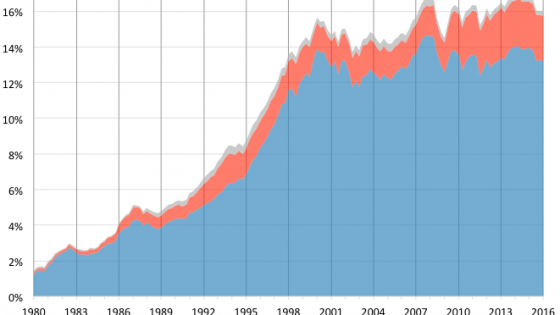Delegated portfolio management, especially through purchases of mutual funds, is a way through which households can improve their portfolio allocation earning returns and risk diversification they might not obtain otherwise. However, investing in active mutual funds requires in turn a substantial amount of financial expertise and efforts. Investors must choose among potentially thousands of funds and, after entry, monitor their performance and management costs so as to decide whether to withdraw or to increase their stake in the funds.
Several empirical studies questioned consumers’ ability to take wise decisions when selecting investment funds. Relative to households, institutional investors are presumably more capable of evaluating managers skills, recognising hidden costs, and possibly exercising market governance, thanks to economies of scale in information acquisition leading to relatively lower search costs. A strand of the empirical literature thus looks at differences between institutional mutual funds and retail mutual funds and finds evidence that the first tend to be better managed. Active funds serving big institutional clients tend to overperform, both before and after adjusting for risk and expenses (James and Karceski 2006) and money flows towards institutional funds appear to respond to more sophisticated criteria than flows to retail funds (Evans and Fahlenbrach 2012, Salganik-Shoshan 2016). Gerakos et al. (2021) provides evidence consistent with the idea of an efficiently inefficient market (Gârleanu and Pedersen 2018), where large institutions engage in costly search to identify skilled managers and obtain positive risk-adjusted returns; this overperformance is paid for by other investors, that earn negative risk-adjusted returns (among which retail mutual funds clients).
In Della Corte and Santioni (2022), we contribute to this literature by examining the characteristics and performance of a large sample of euro area retail funds over the period from 2009 to 2020. A peculiar feature of our work is that we do not contrast the performance of purely institutional funds and retail funds, but we look at how changes in the investor base of retail funds (which are also traded by institutional investors) are related to their performance and characteristics. All the funds we look at are thus available to households. Indeed, the main advantage of the dataset that we assembled, which combines Morningstar data with the Securities Holdings Statistics produced by the Eurosystem, is that we can directly observe the amount of each fund held by households and by institutional investors and we do not need to infer the investor base of the fund based on its characteristics (e.g. the presence of institutional share classes, thresholds on the minimum amount to invest to enter the fund, or the presence of a separate account). Furthermore, while most empirical studies look at the US market, we provide a new perspective by exploring the role of the investor base for the euro-area retail market, whose size is similar to that of the US market but which has received however relatively little coverage so far.
Mutual funds with a higher share of retail investors under-perform
In our econometric analysis, funds’ performance (‘alpha’) is a function of households’ share (i.e. the share of the fund held by euro-area households), fund net flows, flows daily volatility, past performance, fund and family size, fund and family age, as well as fund liquidity and the total expense ratio (TER). As in Pastor (2020), we follow the standard practice in the literature and measure funds’ performance by their risk-adjusted net return and estimate this using the multifactor asset pricing model by Fama and French (Fama and French 2015, 2017) plus momentum (Carhart 1997).
Our first set of estimates shows that the households share is strongly negatively associated with fund performance. We find that as we move from funds held by households by one-quarter to funds where households represent three-quarters of the investor base, there is a loss in the risk-adjusted return of about 10 basis points (bp) in each quarter (about 40 bp yearly). This is the case even if we control for many fund characteristics and for domicile-time fixed effects.
Mutual funds with a higher share of retail investors also under-perform when we compare the performance of the same fund over-time
To further rule out that our results are driven by an omitted variable bias, we can also include fund fixed effects. Indeed, in our sample we observe that some funds experience a significant shift in their investor base over time (Figure 1), with the average fund recording a shift between households and institutional investors by over 20 percentage points.
Figure 1 Change in the funds’ household ownership share (estimated density function)
Notes: Estimated Gaussian kernel of the density function for the change in household ownership share based on SHS-S (Eurosystem) and Morningstar data. Change in households ownership is defined as the difference for each fund between the maximum and the minimum in the households ownership share. Each observation is weighted by the window over which the fund is in the sample, so that funds covered only for few quarters receive smaller weights.
This allows us to control for unobserved time-invariant fund heterogeneity that may both attract more money from the household sector and determine lower performance by exploiting within-fund changes in the household ownership share. We find that when households hold a larger share of a fund, it is also when the fund tends to perform significantly below its (time) average, ceteris paribus. This could be viewed as evidence that the weaker performance of households’ mutual funds is related to households’ inability to identify risk-adjusted performance, which leads to inertia in leaving (or increasing their holdings in) low-performing (high-performing) mutual funds. The results are confirmed if we look at benchmark-adjusted returns. If inattentive investors offer less incentive to generate alphas, fund managers may instead resort to spend in marketing and distribution channels as means to attract investment.
Inertia in household flows is a potential explanation
With this story in mind, we test for differences between households and institutional investors in the flow-performance relation. Following Del Guercio and Reuter (2014) which studies retail equity funds in the US market, we regress sectoral flows on the lagged four-quarter factor-adjusted alpha of the fund, its lagged four-quarter total raw net returns (i.e. not adjusted for factor exposure), and on a set of controls. The first variable provides a signal of managerial skill, while the second variable controls for more simplistic return-chasing behaviour.
The first result is that flows by both households and institutional investors appear to respond to both risk-adjusted returns and to past raw returns. This is consistent with prior findings on the behaviour of retail mutual funds flows (Chevalier and Ellison 1997, Sirri and Tufano 1998, Del Guercio and Reuter 2014 and Ben-David et al. 2021), as well as with survey data documenting that many retail investors believe past returns to be a strong signal of managerial skill (Choi and Robertson 2020). We also find that institutional investor flows are generally more performance sensitive than households.
The second result that stands out is that flows by households are easier to predict than flows by institutional investors as they exhibit a three-times larger autocorrelation coefficient, and the difference between them is statistically significant at any standard confidence interval level. We suggest a few plausible explanations to this inertia in household flows. First, households typically enter automated investment plans such as retirement accounts, to which they contribute at regular intervals. This, possibly combined with inattention, may lead to sluggish reallocation and strong autocorrelation in flows to funds. Consistent with higher inertia in household flows is also the idea that mutual funds rely more heavily on marketing and distribution channels when they target this clientele: investment in marketing may for instance attract household flows for several subsequent periods, regardless of other fund characteristics. The stronger coefficient on past household flows might thus capture the marketing efforts by mutual funds. Finally, if share classes held by households more often come with back-end loads attached, as is likely the case, the incentive to withdraw money from low-performing funds would be lower, even for attentive households.
Conclusions
Overall, our empirical results are consistent with theoretical models where small investors (households in our case) face relatively higher search costs in the asset management market, and thus behave as ‘noise allocators’ (Garleanu and Pedersen 2018). An implication is that innovations that make the market more transparent, such as investor protection regulation or improved information technology that allow easier comparability among mutual funds, may be particularly beneficial to this type of investors.
Authors’ note: The opinions expressed here are those of the authors and do not involve the Banca d'Italia. We would like to thank Massimiliano Affinito, Rui Albuquerque, Francis Breedon, Stefano Federico, Alberto Felettigh, Javier Gil-Bazo, Jonathan Reuter, Philip E. Strahan and Luca Zucchelli for comments and suggestions. We thank Morningstar for access to data, and Emanuela Bassi and Francesco Paganelli for valuable advice.
References
Ben-David, I, J Li, A Rossi and Y Song (2022), “What Do Mutual Fund Investors Really Care About?”, The Review of Financial Studies 35(4): 1723–177.
Carhart, M M (1997), “On persistence in mutual fund performance”, Journal of Finance 52(1): 57–82.
Chevalier, J and G Ellison (1997), “Risk taking by mutual funds as a response to incentives”, Journal of Political Economy 105(6): 1167–1200.
Choi, J J and A Z Robertson (2020), “What Matters to Individual Investors? Evidence from the Horse’s Mouth”, Journal of Finance 75(4): 1965–2020.
Del Guercio, D and J Reuter (2014), “Mutual fund performance and the incentive to generate alpha”, Journal of Finance 69(4): 1673–1704.
Della Corte, V and R Santioni (2022), “The performance of household-held mutual funds: evidence from the euro area”, Bank of Italy Working Papers, forthcoming.
Fama, E F and K R French (2015), “A five-factor asset pricing model”, Journal of Financial Economics 116(1): 1–22.
Fama, E F and K R French (2017), “International tests of a five-factor asset pricing model”, Journal of Financial Economics 123(3): 441–463.
Evans, R B and R Fahlenbrach (2012), “Institutional investors and mutual fund governance: Evidence from retail-institutional fund twins”, Review of Financial Studies 25(12): 3530–3571.
Gârleanu, N and L H Pedersen (2018), “Efficiently Inefficient Markets for Assets and Asset Management”, Journal of Finance 73(4): 1663–1712.
Gerakos, J, J T Linnainmaa and A Morse (2021), “Asset Managers: Institutional Performance and Factor Exposures”, Journal of Finance 76(4): 2035–2075.
James, C and J Karceski (2006), “Investor monitoring and differences in mutual fund performance”, Journal of Banking and Finance 30(10): 2787–2808.
Pastor, L and M B Vorsatz (2020), “Mutual Fund Performance and Flows during the COVID-19 Crisis”, The Review of Asset Pricing Studies 10(4): 791–833.
Pastor, L and M B Vorsatz (2020), “Mutual fund performance and flows under COVID-19”, VoxEU.org, 30 July.
Salganik-Shoshan, G (2016), “Investment flows: Retail versus institutional mutual funds”, Journal of Asset Management 17(1): 34–44.
Sirri, E and P Tufano (1998), “Costly search and mutual fund flows”, The Journal of Finance 53(5): 1589-1622.




